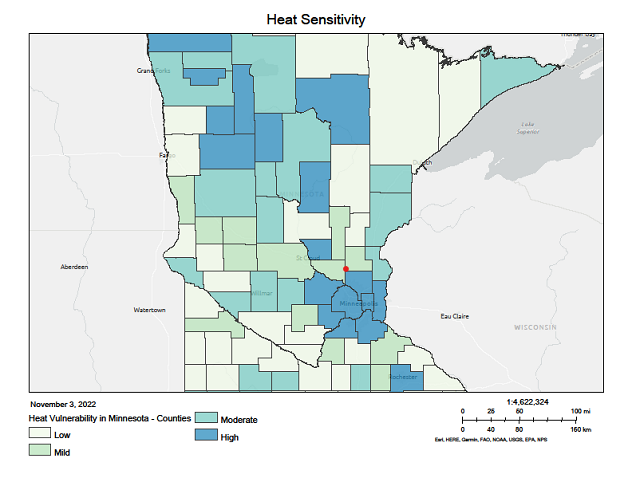Commercial, Energy Efficiency, GHG Emissions - July 5, 2023 - By Better Buildings
Allina Health: Leadership in Climate Risk Vulnerability Assessments
Allina Health conducted a climate resilience assessment to ensure their buildings are prepared for the impacts of climate change. Allina Health used a climate risk vulnerability tool from the University of Minnesota and State of Minnesota to understand climate change-related building and community infrastructure vulnerabilities and evaluate what percentage of its building portfolio is at risk for weather-related and public health disasters. As a result of this process, Allina Health’s sustainability team incorporated their findings and coordinated across teams to ensure the health system is prepared to provide undisrupted patient care and support to the local community in the event of climate-related disasters.
Policies
Allina Health prioritizes excellent patient care while focusing on climate change as a public health threat. The organization recently released its inaugural climate action plan, which details its commitment to reduce greenhouse gas emissions by 50% by 2030 and reach net zero emissions by 2050, increase resiliency to adapt to increasing incidents of extreme weather and the shifting patterns of disease and educate its staff and communities on the challenges and solutions related to climate and the connection to the health of its patients and communities.
Allina Health’s buildings are already being affected by climate change-related weather events. In recent years, Minnesota has been affected by heavier precipitation and a higher heat index than the norm. One of Allina’s largest sites in Minnesota, Abbott Northwestern Hospital, has reported complaints of flooding in the parking ramp. Allina Health contracted a sustainable landscaping consultant to evaluate the issue, and they reported that Abbott Northwestern has a high probability of 100-year floods that could block an emergency room ambulance entrance. With climate change, 100-year floods are becoming more common.
As part of the Climate Action Plan planning process, the sustainability team at Allina Health took steps to meet the goals outlined in their climate action plan to become more resilient and to understand the needs of the community where it intersects with public health. To start building a climate resilience plan, the team conducted a climate risk vulnerability assessment.
Process
Allina Health began the resilience planning process by using a resilience framework to identify and address the most pressing climate-related vulnerabilities and risks to the organization. Using the U.S. Climate Resilience Toolkit Steps to Resilience, Allina Health compiled a list of potential risks that are important to the organization and community (i.e. flooding, air pollution, heat sensitivity, etc.). Then, they assessed which assets are most vulnerable and at risk, investigated possible solutions, and made plans to address the greatest concerns.
To analyze which assets will be most susceptible to climate change, Allina Health used the free Minnesota Climate Change Vulnerability Assessment Tool. This pilot mapping tool incorporates key climate sensitivity variables, including population health, environment, and infrastructure, as well as exposure datasets of historic and projected climate outcomes to support resilience planning in Minnesota.
Users choose the metrics they want to analyze for climate risk (i.e. heat sensitivity, precipitation vulnerability, heat-related illness hospitalizations, etc.), and the tool returns a map of which areas will be most impacted. This data is pulled from various Minnesota state sources, including the State Demographic Center, the Department of Health, the Department of Natural Resources, and the Pollution Control Agency. The tool also incorporates national sources, such as the National Climate Assessment, the National Environmental Health Association, the National Oceanic and Atmospheric Administration (NOAA), and the National Aeronautics and Space Administration (NASA).
Figure 1 shows the number of Allina Health sites at risk under a “business as usual” climate scenario using the analysis tool:
Climate Scenario | Percentage of Allina Health Sites at High Risk | Percentage of Allina Health Sites at Moderate Risk |
Heat Sensitivity | 85% | 2% |
Heat Exposure | 62% | 30% |
Precipitation Vulnerability | 28% | 76% |
Historical Flood and Heavy Rain Events | 23% | 76% |
Figure 1: Climate scenario data assessment | ||
Public Health Outcomes | Percentage of Allina Health Sites at High Risk | Percentage of Allina Health Sites at Moderate Risk |
Asthma hospitalizations per 10,000 (2011-2013) | 59% | 4% |
Heat-related illness hospitalizations | 15% | 2% |
Percent of population without health insurance | 11% | 37% |
West Nile Virus cases per 10,000 | 2% | 3% |
COPD hospitalizations per 10,000 (2012-2014) | 1% | 6% |
Historic public health data assessment (using age-adjusted rates) | ||
* Results are based on historical and projected data using Representative Concentration Pathways (RCP) 8.5 and is used in climate modeling as the predictor of high-emissions climate outcomes also known as “business as usual”.
Figure 2 shows an example of the tool’s Heat Sensitivity analysis in map form:

Outreach
Following the climate vulnerability assessment, Allina Health evaluated which partnerships across their health system would be key to incorporating climate resilience language into existing policies and procedures. In the short term, the sustainability team shared the climate vulnerability assessment data with relevant groups, including Allina Health’s Emergency Preparedness Planning, Population Health, and Community Benefit and Engagement teams.
The Emergency Preparedness Planning team is interested in how weather patterns are predicted to change due to climate change and how they can integrate resilience into action planning. Following the findings of the climate risk assessment, the Emergency Preparedness Planning team plans to incorporate language into existing processes focused on hazard vulnerability assessment, flood risk assessments, and how climate influences the team’s responses.
This resilience work has sparked conversations with the Community Benefit and Engagement team about how Allina Health can use this assessment to integrate with community groups. Allina Health recognizes that risks due to climate change affect the local community outside the scope of its building portfolio.
Outcomes
The priority following this climate risk assessment is to address stormwater flooding at Abbott Northwestern Hospital. As seen in Figure 1, 76% of Allina Health’s sites are at risk of moderate damage due to historical floods and heavy rain events. The health system is communicating with the Mississippi Watershed Management Organization (MWMO) and the city of Minneapolis about mitigation to reduce the impact of heavy rains and flooding. Allina Health is considering installing blue roofs and onsite stormwater collection receptacles. They have already installed a pollinator slope which has a deep root system that absorbs stormwater.
In the medium term, Allina Health plans to take the following actions:
- Work with Emergency Preparedness Planning team to include language about the impacts of climate change in the Hazard Vulnerability Assessments for each facility.
- Work with appropriate staff to identify priority areas with climate resilience overlap and seek opportunities for partnerships. Options may include Community Health Needs Assessment, tree planting, volunteer events, and procurement of sustainable and local food.
- Work with appropriate staff, such as facilities, landscaping and groundskeepers, and operational staff, to include climate resilience in the planning process when creating new building and landscaping projects.
There is an ongoing opportunity to update the climate risk assessment in the coming years based on revisions to the data sources that inform the tool.
This column originally appeared as a blog on the Better Buildings website.
 The Better Buildings Solution Center houses over 3,000 resources shared by Better Buildings partners and other stakeholders. These replicable solutions help organizations bolster their bottom line, advance technology innovation, create jobs, and spur energy efficiency investments.
The Better Buildings Solution Center houses over 3,000 resources shared by Better Buildings partners and other stakeholders. These replicable solutions help organizations bolster their bottom line, advance technology innovation, create jobs, and spur energy efficiency investments.
Read These Related Articles:
Stay Up-To-Date












